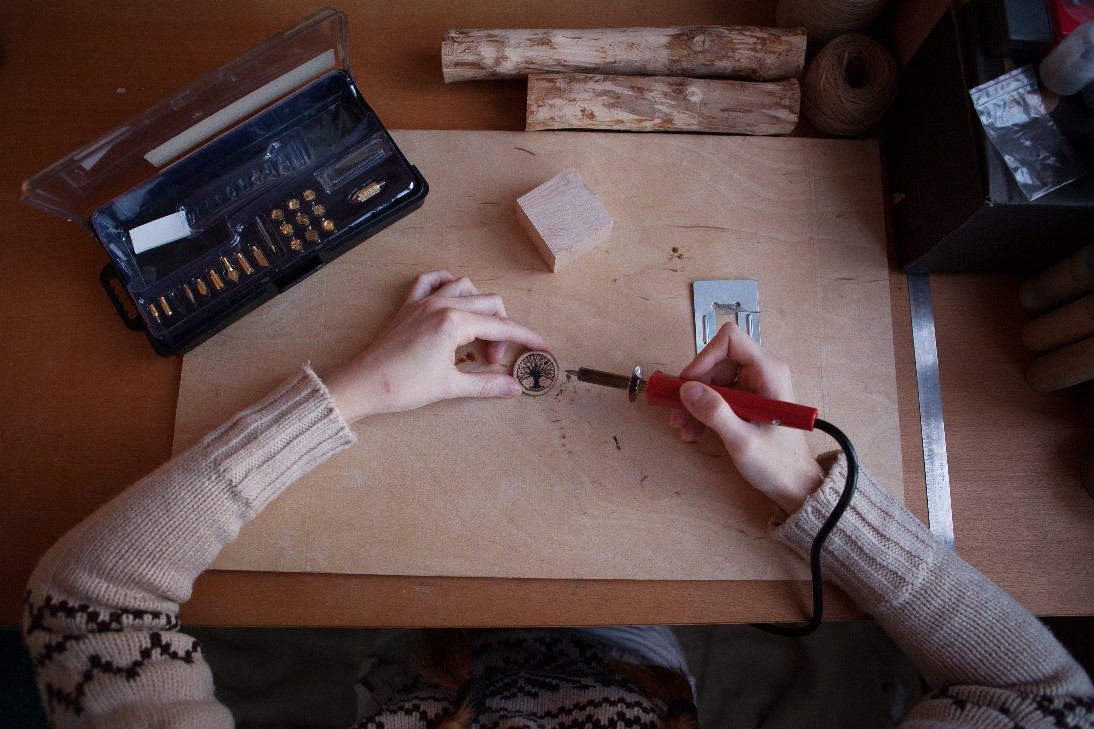The Art of Pyrography
Contents |
Introduction
Pyrography is the process of applying heat to wood to burn marks and decoration into it. By using basic tools such as a soldering iron this method can create works of art from timber.
Sometimes referred to as Pyrogravure, pokerwork or wood burning, by controlling the application of heat with such tools as a poker, a broad range of tones and shades can be applied.
The history of wooden art
The term means ‘writing with fire’ and combines the Greek pur (fire) and graphos (writing). The art of burning wood can be practised using specialised tools and equipment or a metal implement simply heated from fire, or even a magnifying lens concentrated by sunlight. It began in the 17th century, and became increasingly popular by the 19th century, in a crude form of pokerwork.
During the Victorian era, the pyrography machine sparked huge interest in woodcraft, and the term was coined. As time progressed, the 19th century saw an even bigger curiosity, and in the 20th century, the electric pyrography hot wire wood etching machine further automated the process.
Woods and pyrography
This method works best with fine grain woods such as lime, beech or sycamore, which are also best for beginners. For safety reasons, pyrography should not be practised on pressure treated woods or composite materials such as plywood or MDF.
Essentially you can use any wood for a pyrography project, although soft woods will burn at lower temperatures, while harder woods will only take to alteration from higher temperatures. A key point is to prepare your wood. If it is a raw piece of wood, you will need to sand it suitably depending on the way you want the grain. It is much easier to burn with the way of the grain.
Varying the tip, the temperature of the iron, or the way of applying it can achieve many different effects. In most pyrography, after the wood is burned, it is usually coloured. Lighter hardwoods, like sycamore, basswood, birch and beech are a common wood to be used as the fine grain is not obtrusive.
Characteristics of wood in pyrography
The wood you choose in pyrography can change the finished effect. From the hardness, to the grain, figure, texture and colour, the classification of wood will affect the art. Softwood burns faster than hardwood, so do not require the marker to be as hot.
The grain is the direction of the fibres in the cells of the wood - it is important to sand with the grain. It is a key factor, as it can cause deviation when using a woodturning pen unless pressure is applied.
The figure is the natural design or pattern visible from the cut surface of the wood. This should always be taken into consideration when planning your pyrography design. The texture of the wood can also change your planning.
Whether a beginner or an expert, you should avoid creating intricate designs on uneven or coarse wood textures. Wood-burning should simply enhance the natural beauty of the wood, so try not to hide the natural texture, or grain if possible.
Related articles on Designing Buildings
Featured articles and news
Independent Building Control review panel
Five members of the newly established, Grenfell Tower Inquiry recommended, panel appointed.
ECA progress on Welsh Recharging Electrical Skills Charter
Working hard to make progress on the ‘asks’ of the Recharging Electrical Skills Charter at the Senedd in Wales.
A brief history from 1890s to 2020s.
CIOB and CORBON combine forces
To elevate professional standards in Nigeria’s construction industry.
Amendment to the GB Energy Bill welcomed by ECA
Move prevents nationally-owned energy company from investing in solar panels produced by modern slavery.
Gregor Harvie argues that AI is state-sanctioned theft of IP.
Heat pumps, vehicle chargers and heating appliances must be sold with smart functionality.
Experimental AI housing target help for councils
Experimental AI could help councils meet housing targets by digitising records.
New-style degrees set for reformed ARB accreditation
Following the ARB Tomorrow's Architects competency outcomes for Architects.
BSRIA Occupant Wellbeing survey BOW
Occupant satisfaction and wellbeing tool inc. physical environment, indoor facilities, functionality and accessibility.
Preserving, waterproofing and decorating buildings.
Many resources for visitors aswell as new features for members.
Using technology to empower communities
The Community data platform; capturing the DNA of a place and fostering participation, for better design.
Heat pump and wind turbine sound calculations for PDRs
MCS publish updated sound calculation standards for permitted development installations.
Homes England creates largest housing-led site in the North
Successful, 34 hectare land acquisition with the residential allocation now completed.
Scottish apprenticeship training proposals
General support although better accountability and transparency is sought.
The history of building regulations
A story of belated action in response to crisis.
Moisture, fire safety and emerging trends in living walls
How wet is your wall?
Current policy explained and newly published consultation by the UK and Welsh Governments.
British architecture 1919–39. Book review.
Conservation of listed prefabs in Moseley.
Energy industry calls for urgent reform.






























